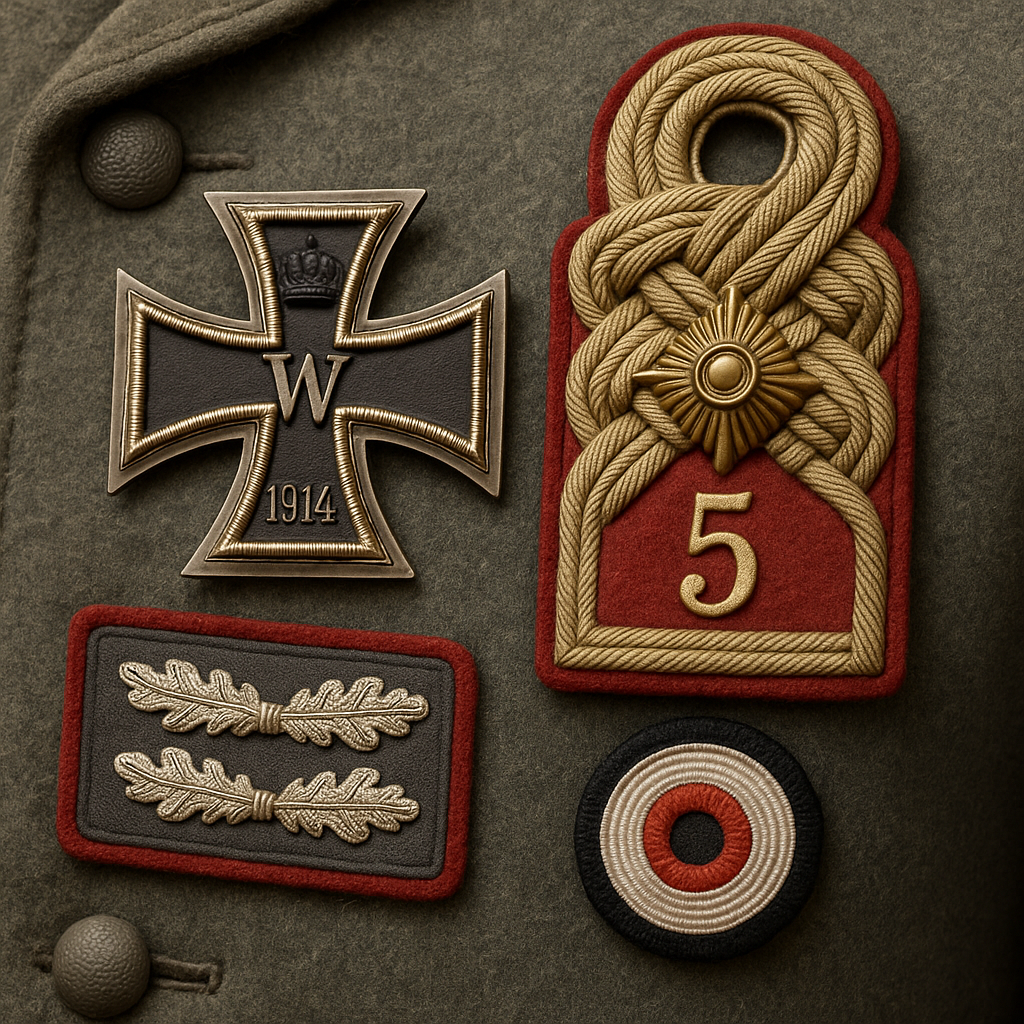
WW1 German Uniform Insignia: Symbols of Honor, Rank & Legacy
Published on Jun 15, 2025
🪖 WW1 German Uniform Insignia: Symbols of Honor, Rank & Legacy
German military uniforms from World War I carry rich historical significance, not just in their structure and design but also in the insignia sewn into the fabric. These symbols reflected rank, regiment, branch of service, and individual honours, offering a visual representation of a soldier's military story.
In this article, we take a closer look at WW1 German uniform insignia and their evolution into later eras, including the 1939 Iron Cross and Third Reich-era badges.
🧵 1. Origins of German Army Insignia in WW1
The Imperial German Army, known as the Deutsches Heer, entered WW1 with a structured yet somewhat decentralized uniform and insignia system. Each German state (like Prussia, Bavaria, and Saxony) had its regiments with minor variations in uniforms and insignia. Despite this, several common themes defined WW1 German insignia.
Key insignia elements included:
- Shoulder boards: Used to denote rank and regiment number
- Collar tabs (Kragenspiegel): Indicated branch of service
- Sleeve insignia: Often used for special qualifications or unit designations
- Cockades: National and state identity symbols on headgear
- Iron Cross: The most recognized military award of the time
🎖️ 2. The Iron Cross – Origins and 1939 Revival
Perhaps the most iconic German military award is the Iron Cross. First established in 1813 during the Napoleonic Wars by King Friedrich Wilhelm III of Prussia, it was awarded for acts of bravery.
🕰️ WW1 Iron Cross
- 1914 Iron Cross (EK II and EK I) was awarded during WW1.
- Displayed on uniform tunics, often in the form of a ribbon in the buttonhole or a pin-on medal.
🔄 The 1939 Iron Cross
Under Adolf Hitler, the Iron Cross was revived in 1939 with a swastika added to its centre. This is known as the 1939 Iron Cross, part of the Third Reich insignia system.
- Although a different era, the symbolic continuity ties back to WW1.
- It reflected Germany's emphasis on legacy and martial pride.
Collectors and historians often compare the design elements of the 1914 and 1939 Iron Cross, noting the change in insignia from Imperial to Nazi-era Germany.
🧩 3. German Army Rank Insignia in WW1
Rank insignia in the German Army were largely displayed on shoulder straps (Schulterklappen) and collar tabs. Let's break them down:
👨✈️ Officer Ranks
- Officers had braided shoulder boards, often with pips or bars.
- Collar tabs were often silk-thread embroidered with fine detailing.
- Officers' insignia was usually more ornate and colourful.
👨🔧 Non-Commissioned Officers (NCOs)
- NCOs wore Tresse (silver lace) on their collars and cuffs.
- Their shoulder straps often had unit numbers and coloured piping.
👨🎓 Enlisted Men
- Enlisted soldiers had simple fabric shoulder straps with color-coded piping.
- Their insignia focused more on unit identification than personal rank.
🪧 4. Branch Colors (waffenfarbe) and Their Importance
A unique feature of German military uniforms was the use of Waffenfarbe – branch-specific colours shown in:
- Piping on shoulder straps
- Collar tabs
- Cap bands
Examples:
- White – Infantry
- Red – Artillery
- Black – Engineers (Pioneers)
- Green – Jäger (light infantry)
- Gold/Yellow – Cavalry
These colour schemes carried over into the uniforms of WW2 and the Third Reich, showing how WW1 German uniform insignia laid the groundwork for future designs.
🧷 5. Common Insignia Materials and Placement
WW1 German insignia were made using a variety of materials:
- Wool or felt backing
- Embroidered cotton or silk thread
- Metallic thread for officers
- Stamped metal for some badges and awards
The placement of insignia followed strict regulations:
- Shoulder boards: Regiment number + branch piping
- Collar tabs: Branch colour and NCO/Officer distinction
- Cuffs and sleeves: Specialty insignia or chevrons
🏅 6. Evolution Into Third Reich Military Symbols
The end of WW1 didn't end the use of many of its insignia styles. In fact, they evolved into what we now recognise as Third Reich military insignia.
- Iron Cross 1939: Carried over WW1 design, with Nazi symbolism added
- German Army insignia (Wehrmacht): Borrowed piping, shoulder strap style, and rank system
- SS and Luftwaffe insignia: Developed independently but shared traditional elements
Collectors often seek both WW1 and WW2-era insignia, and the ability to identify cross-era features is critical.
🧠 7. How to Identify Authentic WW1 German Insignia
With replicas and reproductions common, especially in the militaria collecting world, here are some tips for spotting authentic WW1 German insignia:
- Material: Original pieces are made from aged wool or felt, not synthetic
- Stitching: Hand-stitched or machine-stitched with thick thread
- Wear and patina: Genuine items often show natural aging
- Provenance: Items with documentation or sourced from trusted dealers (like Paddelaters.com) are more likely to be real
🛒 Where to Find Authentic WW1 Insignia Today
At Paddelaters.com, we specialize in authentic, high-quality WW1 and WW2 German uniform insignia. From original 1939 Iron Cross medals to German Army rank insignia, our collection is curated for historians, collectors, and reenactors.
Each item is hand-selected and verified for authenticity to ensure our customers get a piece of true military history.
🔚 Conclusion: More Than Just Fabric – A Story of History
WW1 German uniform insignia represent more than rank—they are symbols of national identity, military pride, and personal valour. Whether it's the legendary Iron Cross, state cockades, or coloured piping, each piece tells a story.
As military history enthusiasts and collectors continue to seek these items, understanding their background helps preserve their significance and connect the past to the present.
